Marseille’s Boubacar Kamara (184cm/6’0, 68kg/150lbs) is in one of the most interesting positions of any player as we approach the 2022 summer transfer window. The 22-year-old’s Marseille contract is set to expire at the end of June and I believe the player will, or at least should, be one of the most sought-after names on the market.
The Marseille man most commonly plays as a holding midfielder, though he has also played plenty of games as a centre-back during his career and is very comfortable in that position too. I believe the holding midfield position is one of the most unique and perhaps demanding ones in the modern game, as well as being one of the most difficult positions to recruit players for due to its unique and demanding nature. However, I also believe that Kamara is someone who can operate in this position to the absolute highest standard, and with the 22-year-old on the verge of becoming a free agent, I think this should make him a priority target for many of Europe’s elite, with top players in this position few and far between.
In this scout report and tactical analysis piece, I intend to provide some insight into the intricacies of Kamara’s game to explain why I feel he’s likely to be/should be so in-demand this summer. I’ll discuss some of the key strengths and weaknesses of his game as it pertains to what’s important regarding his ideal role in the team’s overall structure, strategy and tactics, while also providing analysis of the Marseille man from tactical, technical and physical perspectives.
Passing ability
The first section of this tactical analysis piece focuses on Kamara’s technical passing ability. Of course, this is an important quality for the holding midfielder/centre-back, with these deeper-lying players usually spending more time with the ball at their feet and being required to make more passes than any other player on the pitch. Additionally, they’re increasingly required to kickstart attacking moves, with increased importance being placed on playing out from the back through these players.
Kamara’s passing numbers are highly impressive when looking at them through the scope of a holding midfielder; he excels in 1. Ball retention and 2. Ball progression, though admittedly the latter to a lesser extent than the former, with some better ball progressors perhaps around. Nevertheless, Kamara’s still very good as a ball progressor, make no mistake about that.
Per Statsbomb via FBRef, over the last calendar year, some notable areas in which Kamara stands out numbers-wise when compared to other midfielders from Europe’s top-five leagues are: passes completed (95th percentile), pass completion percentage (94th percentile), passes to the final third (87th percentile) and passes under pressure (87th percentile).
His performance in these metrics is linked to Kamara’s heavy usage in the deeper areas of the pitch during the build-up and ball progression phases. He must be reliable in these areas during these phases of play to ensure cheap ball losses and dangerous transitions leaving the team vulnerable at the back don’t occur, and Kamara is undoubtedly reliable in this way, as is evident from his stellar pass completion rate and a high number of passes under pressure, indicating how comfortable he is with attracting pressure from opposition players in these deeper areas along with how comfortable his teammates are with giving him the ball in high-pressure situations in these positions.
Furthermore, Kamara’s solid performance in passes to the final third is indicative of his role in ball progression and ensuring his passes take the team from their own third or the middle third of the pitch to the final third with the ball at the feet of the team’s more directly creative players who can attempt to invade the opposition box.
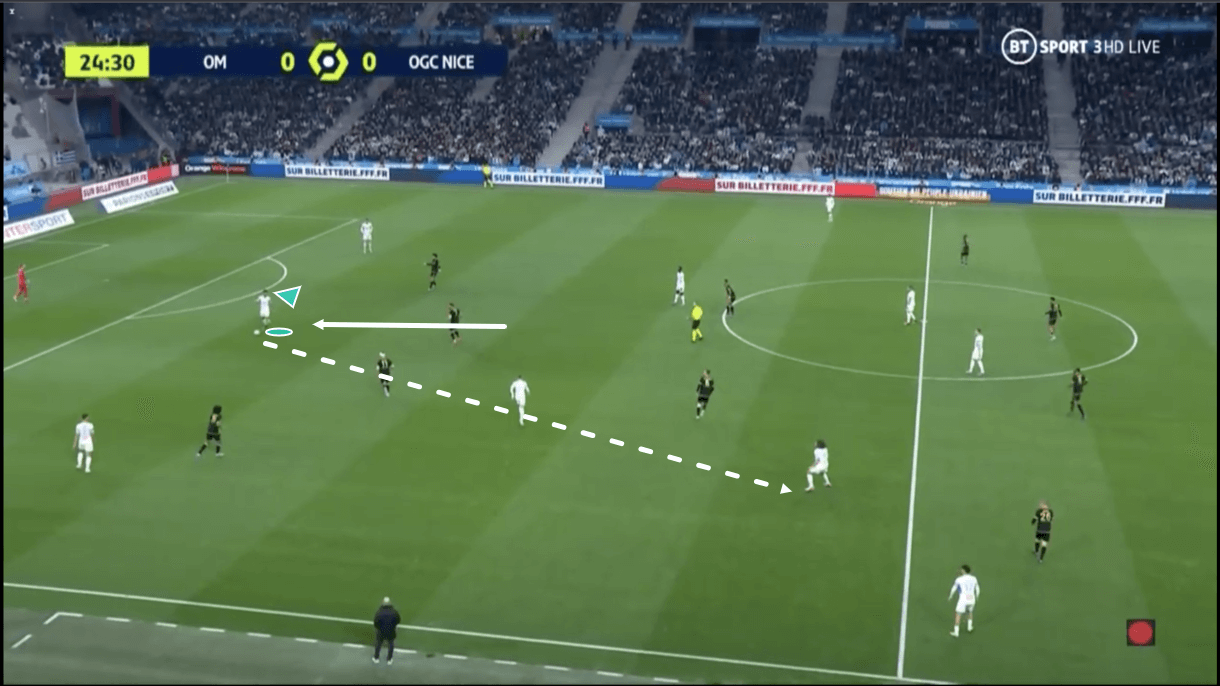
Even when deployed as a holding midfielder, as has been pretty standard for the 22-year-old this season, it’s common to see Kamara drop deep during the build-up/ball progression phases, even occupying a position in the first line of attack in between the centre-backs on either side of him. Marseille’s general structure in the build-up/ball progression phases under the enigmatic Jorge Sampaoli was detailed by me in this tactical analysis piece for Total Football Analysis: Ligue 1 2021/22: Three tactical tweaks that spotlight Marseille’s evolution under Jorge Sampaoli – tactical analysis for those of you who’d like to build your knowledge on Marseille and their tactics under the Argentinian coach as a whole even further, which may help with gaining a greater understanding of how Kamara ends up in this position as seen in figure 1 and what his responsibilities are in such a position compared to when he’s positioned in the second line of attack, as is also common.
Essentially, though, Kamara will often end up here when his team requires a third man in the first line to have a +1 advantage over the opposition’s first line of pressure, which helps the team in their attempts at ball progression. In figure 1, Kamara identified this need to drop into the first line and did so diligently. When he got on the ball, he got his head up, took the ball onto his stronger right foot, spotted the option of finding Mattéo Guendouzi in the right half-space and executed his pass excellently, lofting it into the path of his midfield teammate. It’s common to find Guendouzi in this kind of position during possession phases for Marseille this term and it’s common to see a combination between him and Kamara during ball progression, with Kamara favouring his right foot quite heavily, leading to Guendouzi in the right half-space often being a natural progressive passing option for the holding midfielder.
Kamara loves to get his head up and quickly scan in positions like this as well as when receiving with his back to goal in a slightly more advanced position. He’s a frequent scanner which is evident from watching him play, and he also tends to scan at the right moments — in between teammates’ touches or after the ball has left the teammate’s foot for a pass and is travelling — all of which helps his decision-making on the ball through having greater information.
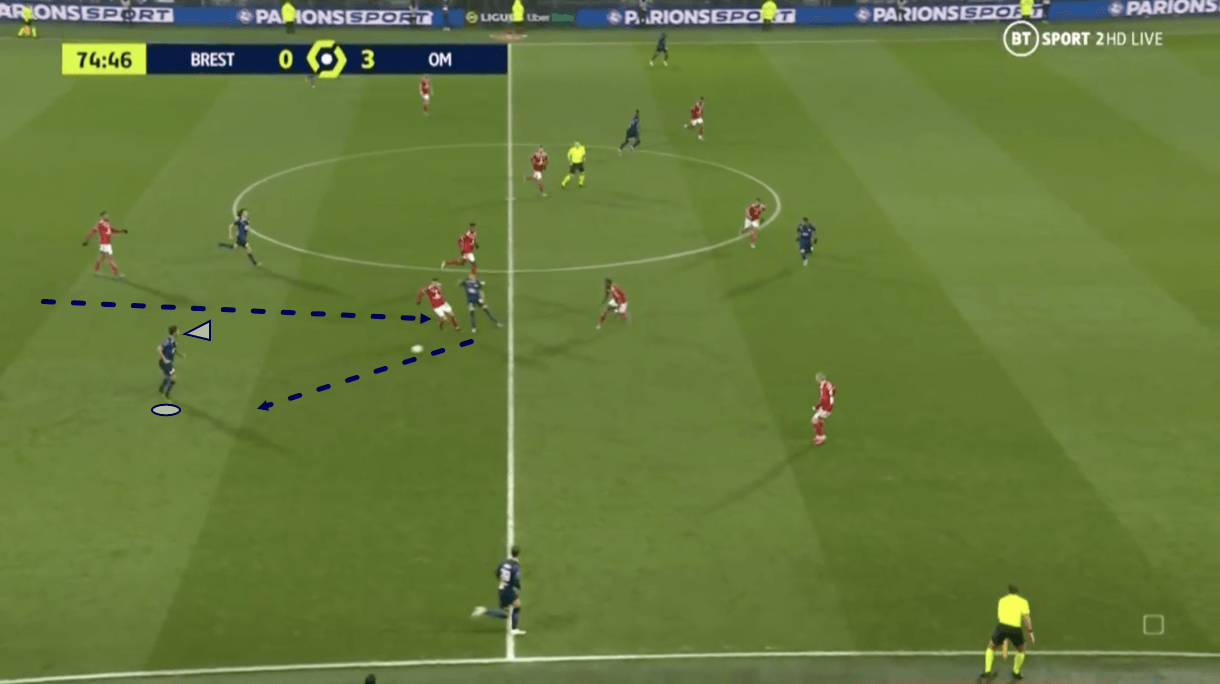
Figures 2-3 show an example of Kamara progressing the ball through the opposition’s high backline, sending a teammate through on goal. Just before this image, the midfielder’s central midfield teammate received the ball from one of the deeper players, with the passing lane into Kamara having been blocked off. As this midfielder received the ball, Kamara began facing forward and became a good passing option for this player just to the side. With Kamara now out of the opposition players’ cover shadow and providing a good, forward-facing passing option, the Frenchman received the sideways pass from his midfield partner and was able to get onto the ball in some space while already facing forward and having had time to look around and assess the options ahead of him.
Kamara is often receiving passes either in very deep positions like where we saw him in figure 1 or while playing with his back to goal. This can make it more difficult for him to directly progress the ball, instead leaving him playing the role of attracting pressure and playing the ball off to someone else in more space who can then send it further forward, as Kamara’s midfield teammate does here. However, when given the ball in situations like this where he is facing forward and does have the opportunity to break lines himself, he is happy to take it and possesses the on-the-ball quality to create dangerous chances for his team.
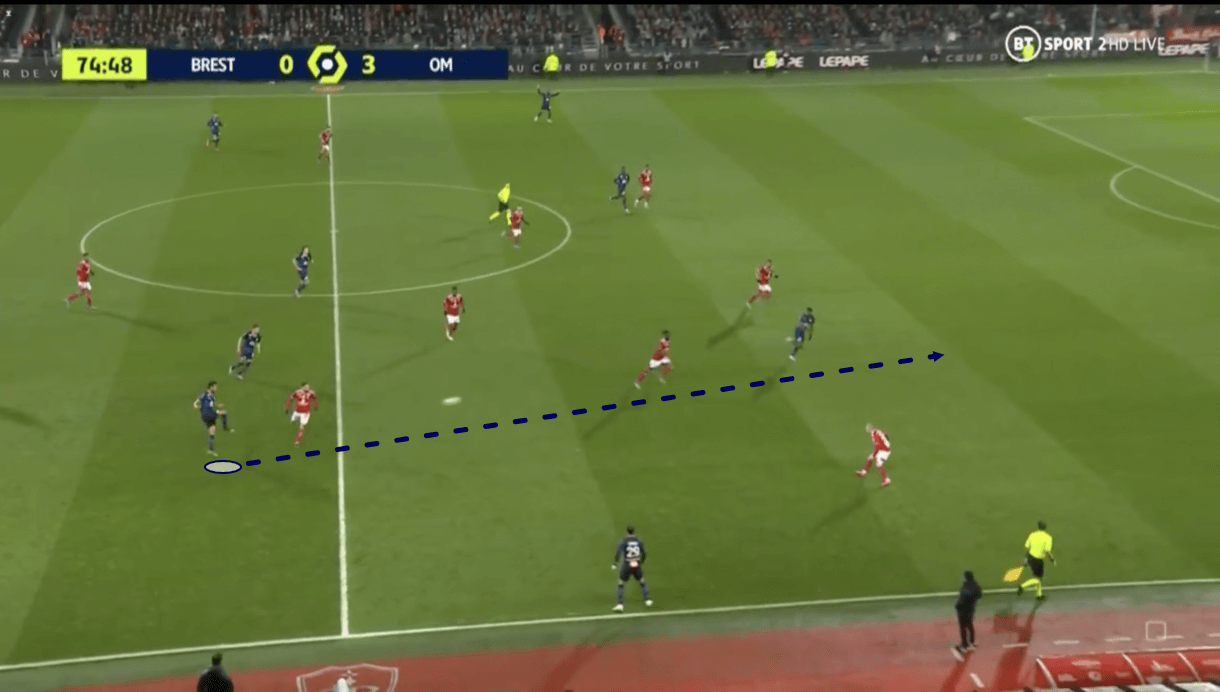
As this passage of play progresses into figure 3, we see how Kamara spotted some good, threatening movement from the right forward ahead of him and drove the ball into his path with a well-weighted through ball. This pass sets the forward off on a dangerous run in behind the opposition’s backline. From this, we see how Kamara is comfortable with playing the ball forward and breaking lines — even the last line of defence — when possible. This is a useful ability that adds some diversity to his skill set, as he’s capable of not just playing the role of ball retention, but also progression and creation from deep thanks to his technical quality and his impressive vision.
Receiving the ball
Passing the ball is one skill — and undoubtedly an important one for a holding midfielder — however, for Kamara, in his role at Marseille, ability to receive the ball has, I’d argue, been more important. This can be an underrated and undervalued skill, at times, but for a holding midfielder in a possession-heavy team that likes to build their attacks through the lines, it’s a vital skill for someone so central to the team’s shape and offensive strategy, both physically and figuratively.
Kamara needs to be available for his teammates to find in the build-up/ball progression phases as much as possible, which he achieves through his spatial awareness, body shape and movement. The Marseille man lies in the 95th percentile among midfielders from Europe’s top-five leagues for passes received, highlighting this important element of his role in the team’s tactics. Marseille have been offensively dominant this season under Sampaoli, retaining the second-most possession (61.1%) on average and scoring the fourth-most goals (44) of any Ligue 1 side at this stage of the campaign (accurate at the time of writing). This would not be possible without Kamara being at the top of his game in his central role within the team’s setup and it’d be fair to say his role is vital for this team in the early stages of attacks.
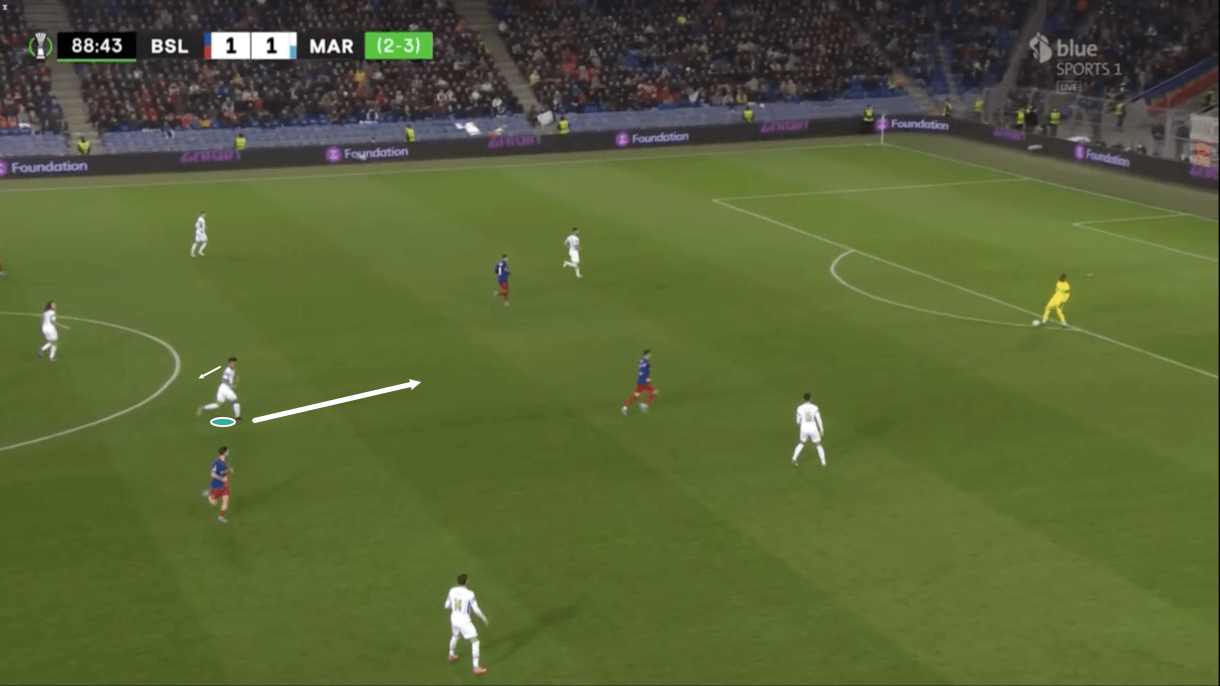
Figure 4 shows an example of Kamara dropping deep during the build-up to help his side break past the opposition’s first line of pressure. Here, we see how the 22-year-old identified that his team needs an extra man in the first line to create the +1 advantage they aim for, and he dropped in between the centre-backs to make this +1 advantage happen. Note how Kamara scans over his shoulders while dropping deep in between the centre-backs to ensure 1. He’s got an accurate picture of how the pitch is laid out at the other end behind him and 2. He’s aware of if and where pressure is coming. This is just one example of the frequent scanning we mentioned in the previous section, which is vital for a player who receives the ball as much as Kamara does, in high-pressure situations.
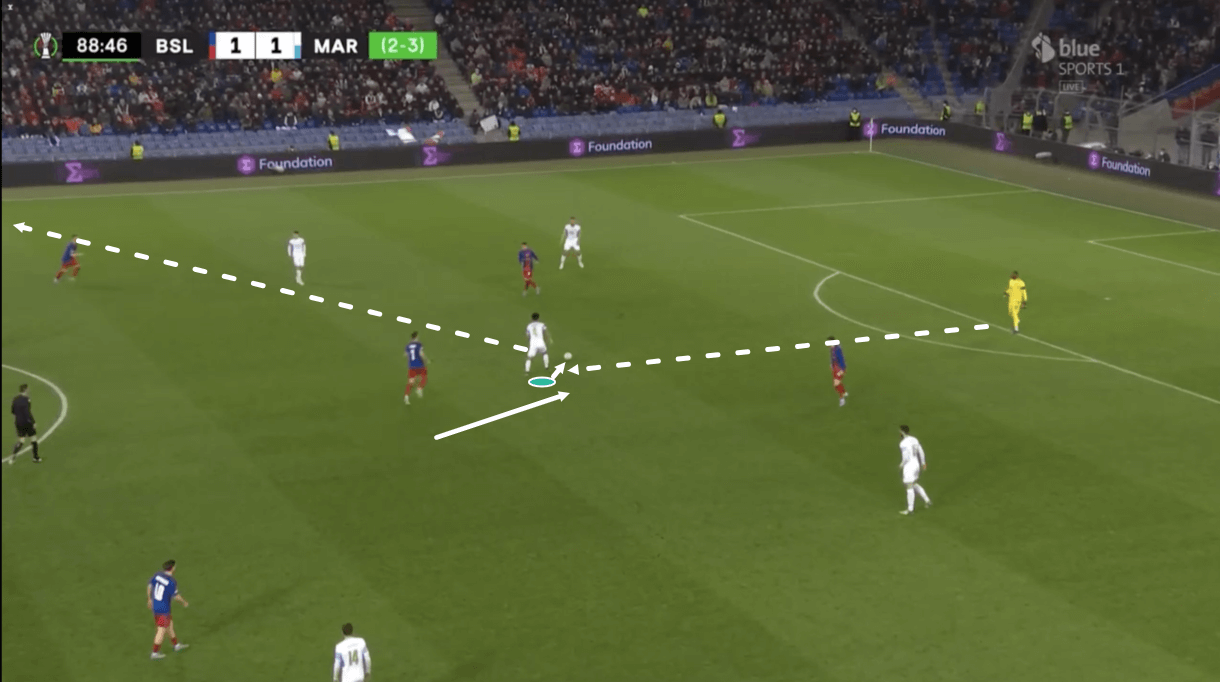
As play moves on into figure 5, we see that Kamara has received the ball in between the centre-backs and has slightly turned towards the right side of the pitch to create an angle to send the ball forward. From here, we see Kamara loft the ball from his position between the centre-backs to a teammate positioned wide on the right-wing who he can set up in a 1v1 with the opposition full-back. It’s worth noting that Marseille’s disciplined, organised offensive structure helps Kamara to have a greater awareness of his teammates’ positioning in an instance like this than he otherwise would, again, like his scanning, helping the accuracy and speed of his decision-making.
It’s quite common to see Kamara play high passes out from areas like this. He has a wonderful passing range and is happy to use it to spread the ball all over the pitch. He’s very good at setting up wide men in 1v1s with opposition full-backs as was the case here through long passes and switches of play, and he enjoys making such passes. Occasionally, he’ll opt for a long pass when a simpler one might be the better option but generally, his decision-making is quite good. He is, however, a risk-taker when progressing the ball. Of course, as someone useful in ball retention, a lot of the time he’s happy to slow things down, play around at the back and wait for the opening to come — he doesn’t rush progression unnecessarily at all. However, when the opportunity to progress does come, he doesn’t tend to hesitate much and really commits to driving the team forward via, for example, the long pass out to the wing that we see here.
When Kamara received this pass, he took a fairly heavy negative first touch. On one hand, this was successful at keeping the ball away from the pressing opposition player on his back, protecting possession in a sensitive area, but at the same time, it was perhaps a little bit too conservative of a first touch and Kamara could’ve afforded himself more leeway to forge a better passing angle here. It may be a fair criticism of the Marseille midfielder to say that he is perhaps too careful with his first touch at times and could work on being bolder at receiving on the half-turn and creating forward passing angles for himself. This would help to make ball progression smoother when moving through the thirds.
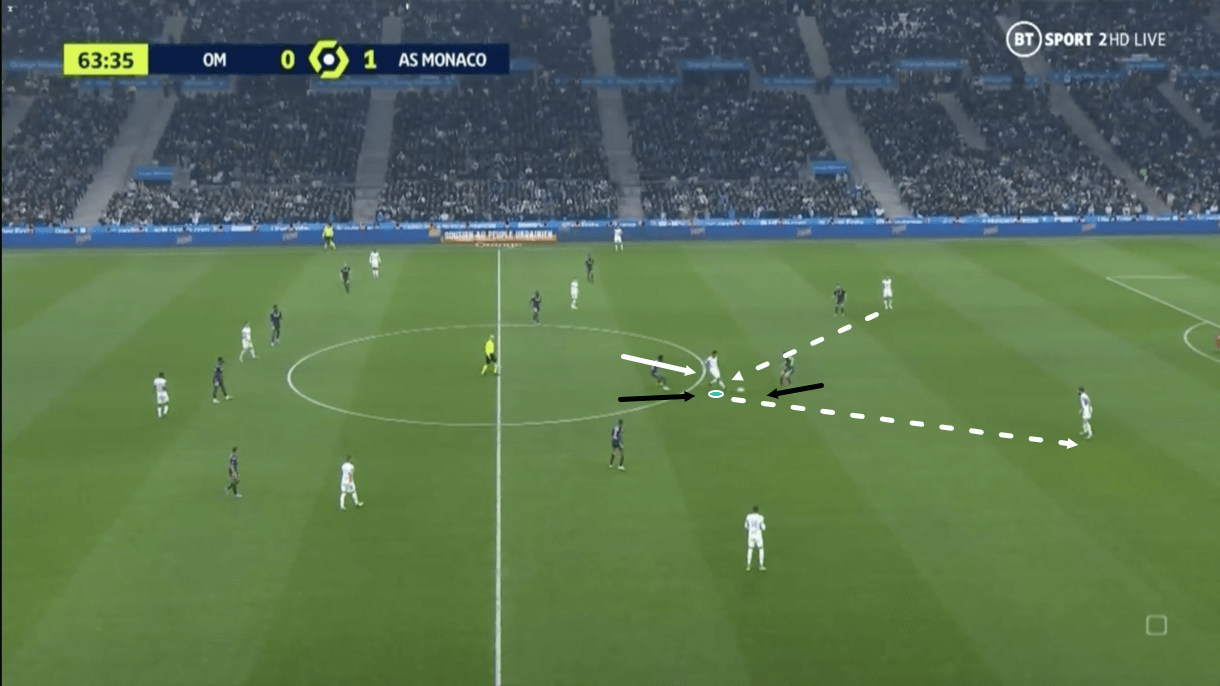
Moving on into figure 6, here we see another example of Kamara receiving deep, under pressure, with his back to goal. As we see more and more examples of this, we recognise how normal this kind of scenario is for the 22-year-old midfielder. Here, he receives from the right centre-back and immediately passes it on to the left centre-back. This was a calm, measured and intelligent decision that was crucial for the team’s ball progression as play progressed from here, which we’ll get onto.
Firstly, though, we can recognise that by making himself available to receive from the right centre-back, Kamara gave this defender a good forward passing option that could relieve some pressure on the backline. Had the ball been played directly from one centre-back to the other, the pressure on Marseille’s first line would’ve been greater, the left centre-back would’ve had even less space on receiving and would have had a more difficult time progressing the team forward from there, likely getting forced into a worse position. With Kamara aiding the team by dropping deep, however, he helped to create a 3v2 advantage versus the opposition’s two strikers, even though he was also under pressure from behind, giving the left centre-back more time and space.
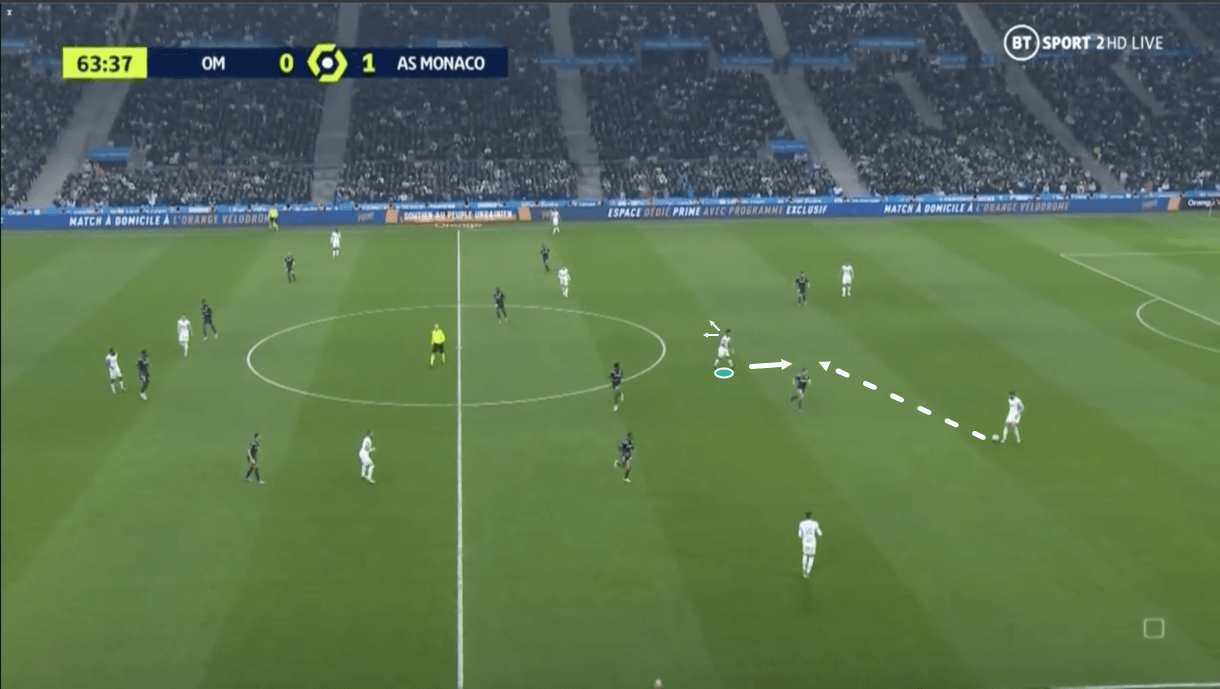
After releasing, Kamara enjoyed much more space and freedom, with the midfielder who was pressing from behind dropping off and the striker who was pressing from the front turning his attention to the left centre-back, though aiming to keep Kamara in his cover shadow while pressing the defender. However, the left centre-back had enough time and space to remain composed, while Kamara had enough time and space to subtly shift out of the opposition player’s cover shadow and make himself available for a return pass from the centre-back following figure 7. During the time the ball was moving back to the left centre-back and in between the player’s first and second touch, Kamara took the time to scan — again highlighting his intelligent timing of scans.
The Marseille man is really good at subtly getting out of the opposition’s cover shadow as we see here, which is an incredibly valuable skill for a holding midfielder. You want this player to be as available as possible for teammates due to the central role they play and Kamara is excellent at providing this service to the team.
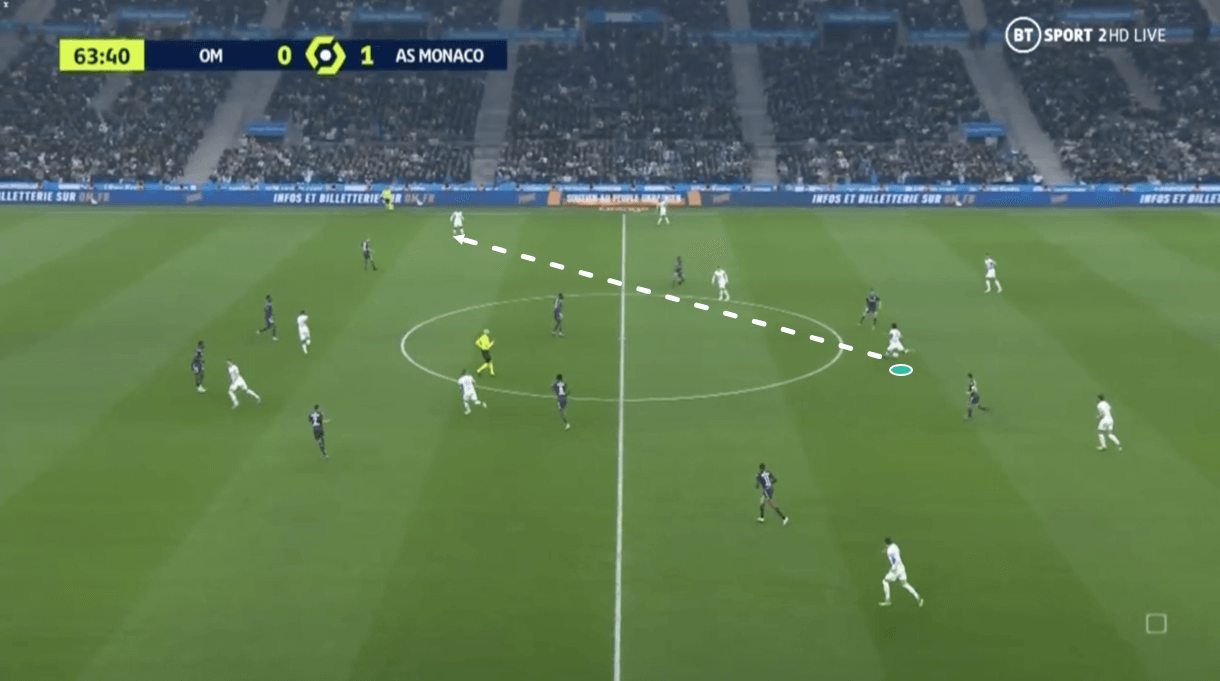
As play then moves on into figure 8, we see how Kamara received the return pass from the left centre-back now in enough time and space to turn, get his head up and spray a long pass out to the right-wing where he can, again, set his right-winger up in a 1v1 with the opposition full-back. This shows how Kamara intelligently and effectively combines his ability to receive the ball very well with his impressive passing range to drive his team upfield.
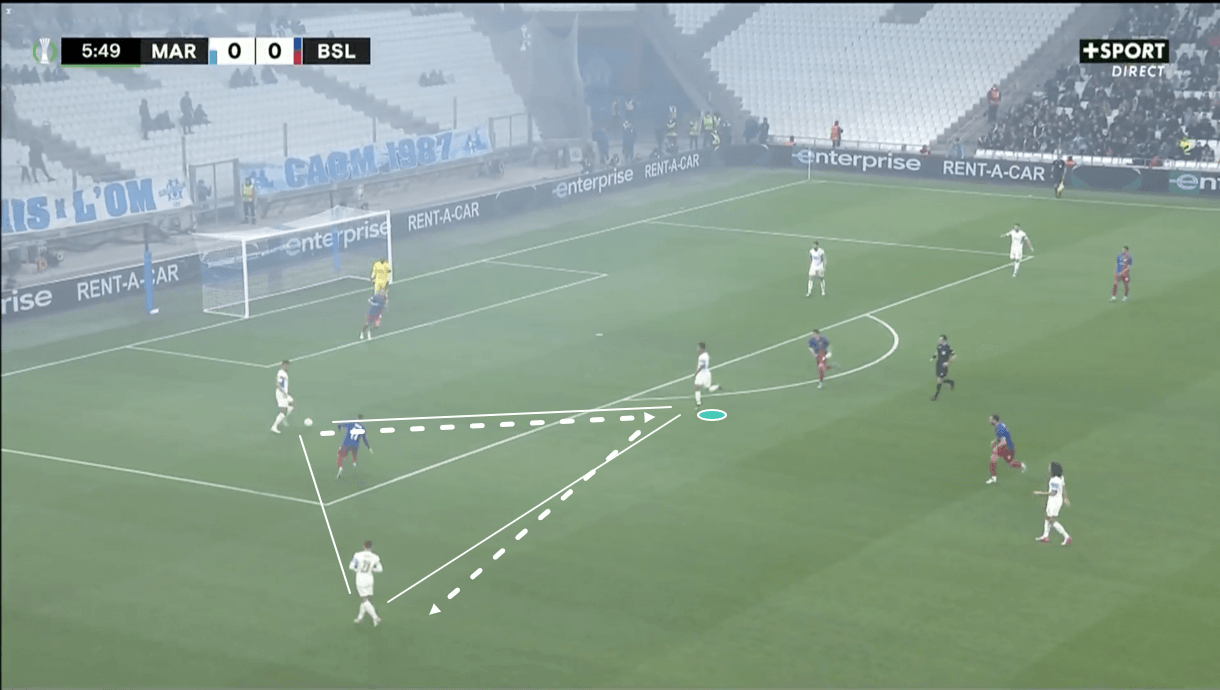
Lastly, through his off-the-ball movement, Kamara is excellent at forming useful triangles and diamonds with his teammates to facilitate movement from A to B by going through C — with C being the Frenchman. Figure 9 shows one example of this, with right centre-back William Saliba, who’s on loan at Marseille from EPL side Arsenal, hoping to progress the ball out to right-back Valentin Rongier, who we can see occupying a lot of space here. This was impossible to achieve directly at this moment due to the pressing angle of the opposition player closing down Saliba. However, Kamara moved into a position where he was able to facilitate ball progression by giving Saliba a simple inside short passing option, receive the pass and immediately send it out to Rongier, who would then be able to look up and get further forward.
This is something very simple but it’s a service that Kamara constantly provides for his team in a very effective way. Again, it’s all about being available and giving his teammates a good, simple option. By doing this, as we see in figure 9, he essentially negates the effectiveness of the opposition player’s press and moves Marseille into the position they want to be in a way that looks effortless and simple but all relies on intelligent, subtle movement provided by Kamara.
Kamara is constantly looking to find and occupy space where he can be available for his teammates and give them a good, simple passing option. By doing so, he helps ball retention by removing unnecessary risk as he gives the team a less risky option, while he helps ball progression as he comfortably attracts pressure and then relays the ball off to a player with more time and space to make a more adventurous next move. Even then, Kamara will typically look to get into a position to give that next player an option as well in case they need it. This is a key aspect of his role at Marseille which he performs very well.
Defensive qualities
Turning our attention to the midfielder’s defensive qualities, Kamara isn’t someone you’ll often see marauding around and aggressively leading the team’s press, rather he tends to perform a more calculated defensive role. What’s perhaps notable about Kamara defensively is that while he lies in the 64th percentile among midfielders from Europe’s top-five leagues in terms of pressures — pressures referring to volume of pressures — he lies in the 98th percentile for successful pressure percentage, highlighting that when he does apply pressure, he tends to come out on top an extremely high amount of the time.
This is partly due to his defensive qualities but also partly due to the defensive system that Sampaoli has set up at Marseille. It’s always easier for a player to perform well defensively when the system is set up in such a way that it allows their strengths to blossom while negating weaknesses through the strength of the collective and not allowing the player to get so isolated in a 1v1 or even overloaded. This is something that did happen to Kamara more often in previous seasons. I recall under André Villas-Boas, that Kamara would sometimes get isolated as the ‘1’ behind midfield in the 4-1-4-1 shape with two or more opposition players overloading this area through their movement and making it difficult for Kamara to occupy/protect all of the necessary space. Sampaoli’s system has been better at preventing this from happening and Kamara has thrived as a result.
Any player can be exposed defensively when they’re left so isolated that they have one player in the left half-space to cover and another in the right half-space to cover while the opposition are in the ball progression phase, centrally, with either option to choose from. This is far less of a problem for Kamara this season, however, which has helped the midfielder to focus more on protecting his area. I believe this has played an important part in Kamara getting dribbled past a lower 0.91 times per 90 this season than the 1.52 times per 90 he was dribbled past in 2020/21.
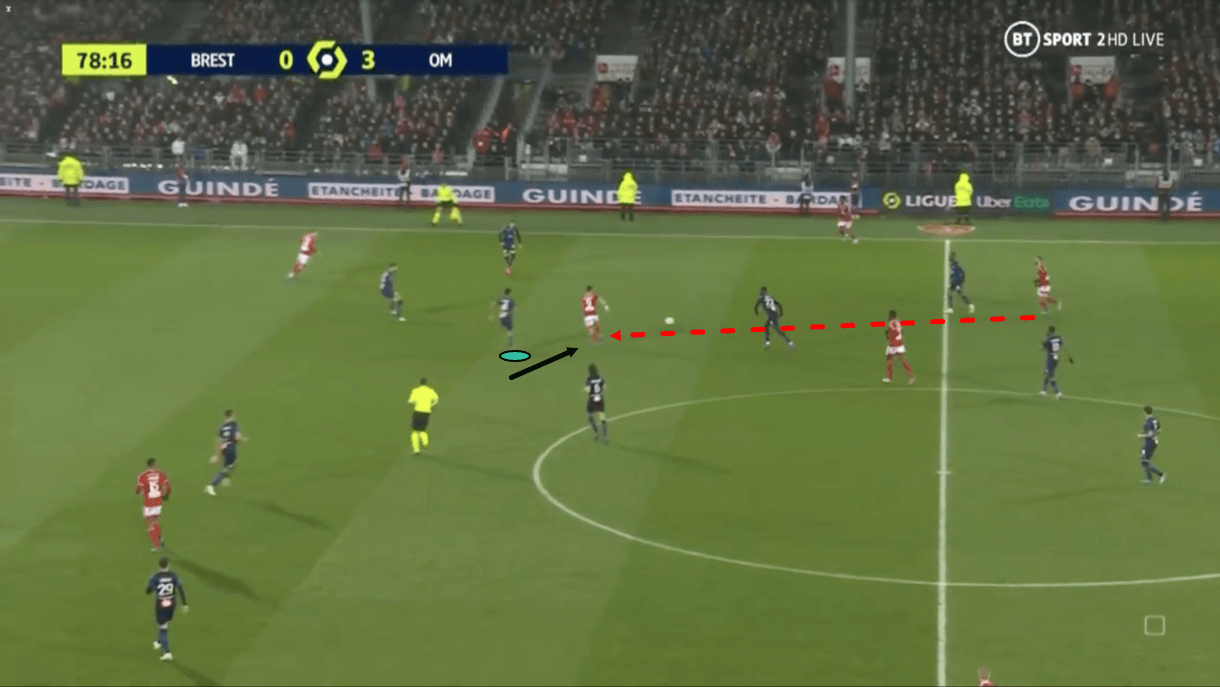
Figure 10 may show an example of how Kamara is helped by the positioning of his right central midfield partner, Guendouzi, who drops in to occupy the central space in front of the backline as Kamara is called into action to press the opposition’s attacking midfielder receiving this pass just in front of the backline.
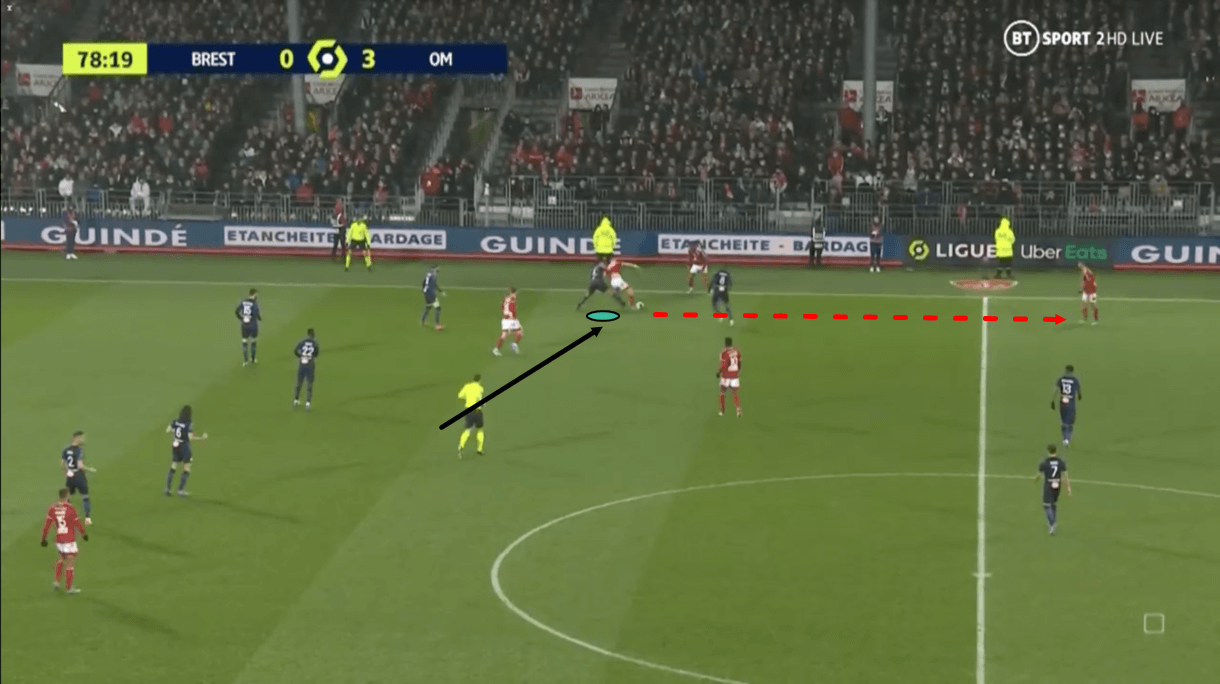
As play moves on into figure 11, we see that left central midfielder Pape Gueye has also dropped deep to cover for Kamara, forming a double-pivot with Guendouzi that’s really vertically compact with the backline, to guard the space the 22-year-old has allowed to open by following the opposition receiver out wide.
Kamara locked onto this player in figure 10 when the ball was sent into his zone and focused on ensuring the player couldn’t turn. As we move on into figure 11, we see how Kamara committed to this task fully by following the player out wide and remaining very tight to him, making sure he continued to find it impossible to turn and run at Marseille’s defence.
Kamara’s body positioning here was very important in preventing the attacker from turning. The midfielder got low into a side-on body position with one leg in front of the other, making it more difficult for the attacker to back into him and influence his balance, as he tried to do. Instead, when the attacker tried to back into Kamara, the midfielder was well prepared to hold his ground and drive the attacker backwards. As play moves on from this image, we see the attacker end up passing the ball backwards. So, Kamara succeeded in preventing any further forward progression from the opposition by aggressively pursuing the attacker once the ball was played into his zone and demonstrating some good defensive basics that made the most out of the strength he possesses to hold his ground and force the opposition to retreat, at least momentarily.
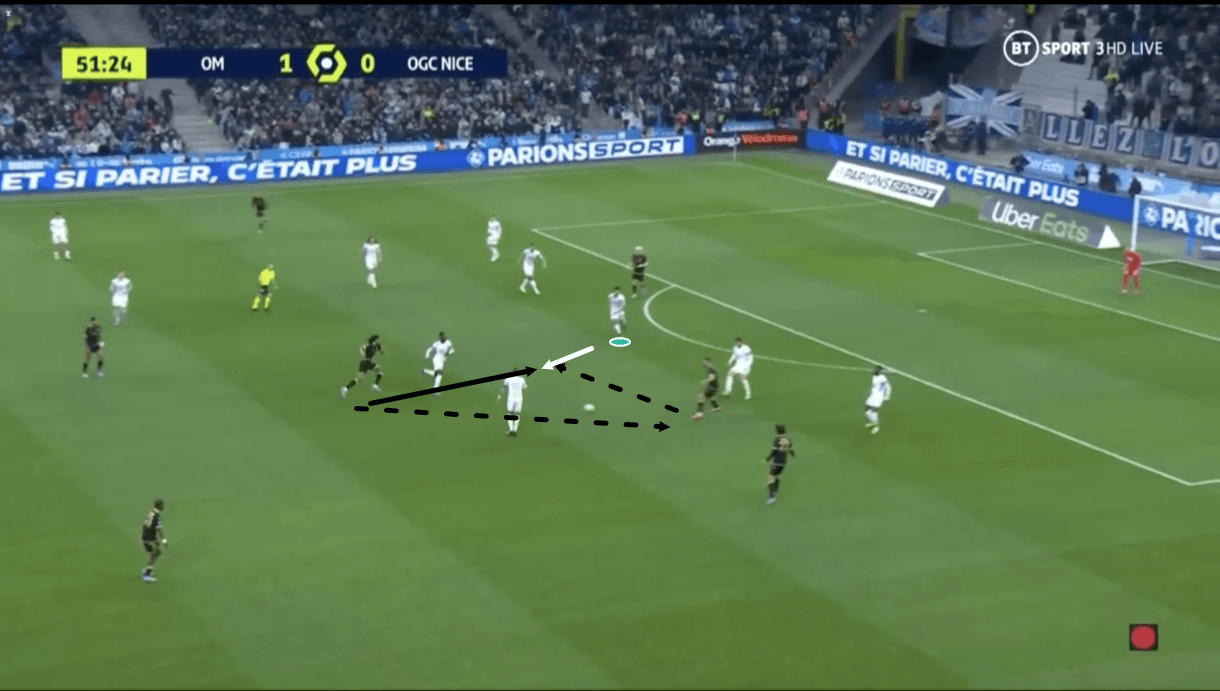
Moving on into figure 12, here in a deeper position, we see Kamara’s zone once again being approached by an opposition attacker who’s hoping to be on the receiving end of a 1-2 to cut through Marseille’s defensive shape. However, we can see that Kamara is alert to the intent and has already aggressively started to shift out from the back to put a stop to this attack.
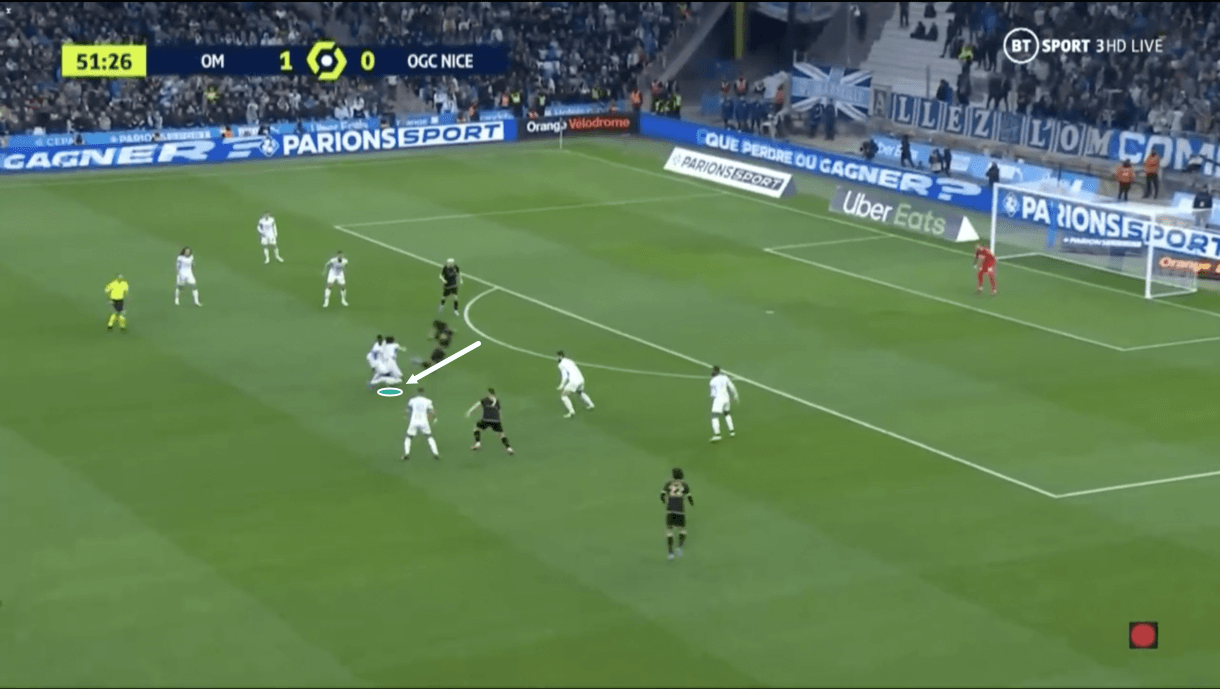
As we progress into figure 13, we see that the opposition attacker was not ultimately on the receiving end of a 1-2, instead ending up on the receiving end of a Kamara tackle. The 22-year-old is a good tackler, he times his tackles well, he’s aggressive and he commits to challenges when necessary. Of course, this can be risky and I would probably encourage Kamara to tone down the aggressive tackling in more sensitive areas, like in his team’s own box. As things stand, he’s comfortable going to ground aggressively in his own box and sometimes too soon to go to ground, leading to the opposition attacker being able to take advantage of his aggressiveness to change direction and expose Marseille as a result of Kamara’s aggressive tackle being unsuccessful. However, as we see here, Kamara’s aggressive nature can be a big plus for his side too as it can put an emphatic stop to potentially threatening attacks, and overall I’d say this aspect of his game is definitely a net positive, even if it has some negatives that can be improved upon — it could be wise for opposition teams to target Kamara’s tendency to go to ground quite regularly and quite early at times, however.
One thing that makes Kamara’s tackling so effective is his speed. He’s very quick in accelerating from a standing position to close down the attacker and stop their move definitively as we saw in figure 13. This also holds true for his reaction speed; mentally, he’s quick to spot danger as it approaches his zone and he’s a decisive person who doesn’t overthink the solution to the incoming problem.
Transition to defence
For the final section of analysis in this scout report, I’ll look at how Kamara is an asset for his team in transition to defence. This is a vital part of the holding midfielder’s role in a ball-dominant team, as transition is where you might automatically think this team can be hurt, for example, after a lengthy period of sustained pressure around the opposition box breaks down and they’re left with fewer bodies than would be ideal back behind the ball in an organised defensive shape.
The holding midfielder will typically play a central role in the team’s rest defence, again, both figuratively and literally. Firstly, before getting into it, again I’d recommend a read of my piece on Sampaoli’s tactics at Marseille this season if you want to know more about the team’s overall defensive tactics and how they shape up offensively in the progression or chance creation phases, as this shape is also part of how they prepare to deal with transitions.
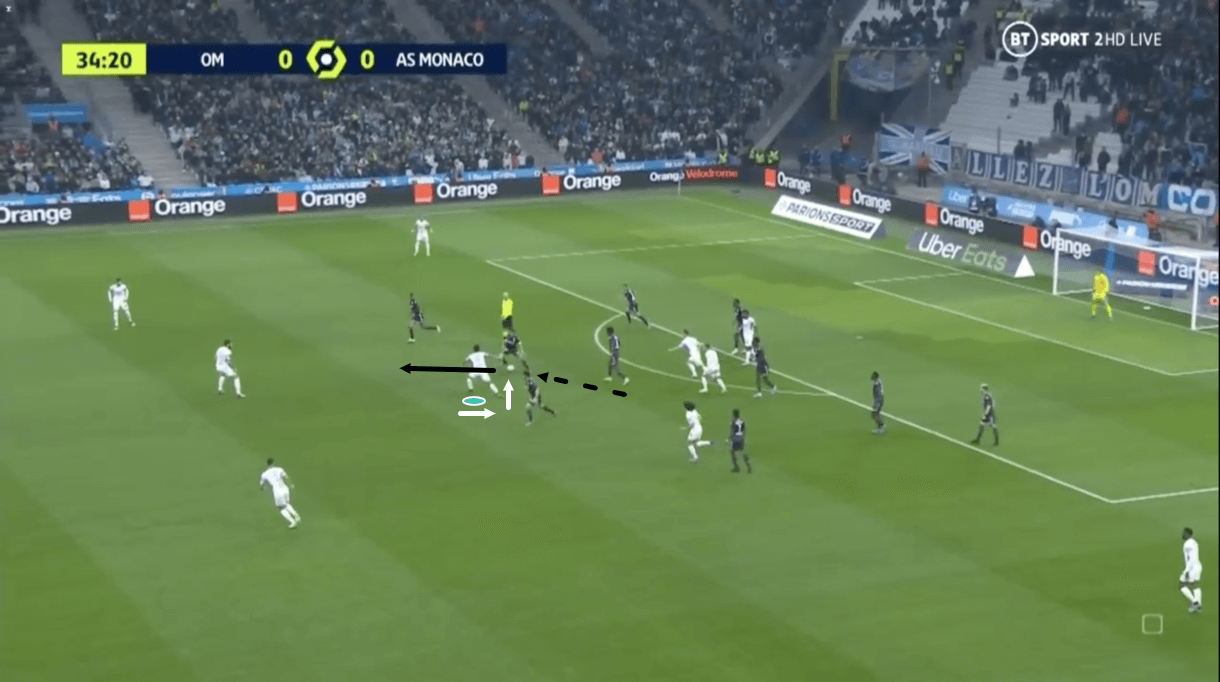
We see an example of Kamara in his central position during the rest defence in the chance creation phase in figure 14. We can see all 10 Marseille outfielders in the image here, which would be particularly risky and perhaps impossible to do should the opposition leave somebody on the halfway line waiting for a long ball up to the top to chase down on the counter.
Even so, however, this is an extremely aggressive rest defence and extremely risky, with opposition players in the process of darting forward to exploit the space behind them and these players perhaps needing to either turn and then run to sprint backwards, which can hurt their awareness of what’s happening on the ball as well as their speed in getting back, or jog backwards while keeping their eyes on the ball — again, which will hurt their speed. It’s also important that these players don’t immediately just sprint back, as keeping a compact defensive structure is incredibly important or else too much space will open up between them and the midfield, which can also be easily exposed by the opposition to potentially devastating effect.
Kamara’s role is very important here as he can slow down the opposition’s transition, buying his teammates time to regroup in an organised defensive shape carefully to deny the opposition any space.
The first thing the 22-year-old does is position himself in the ball-carrier’s nearest, most obvious forward passing channel. By cutting this option off, Kamara forces the ball-carrier, in a high-tempo, high-pressure moment, to assess his other options which buys 1. Kamara time to close the player down and 2. His teammates time to reorganise defensively.
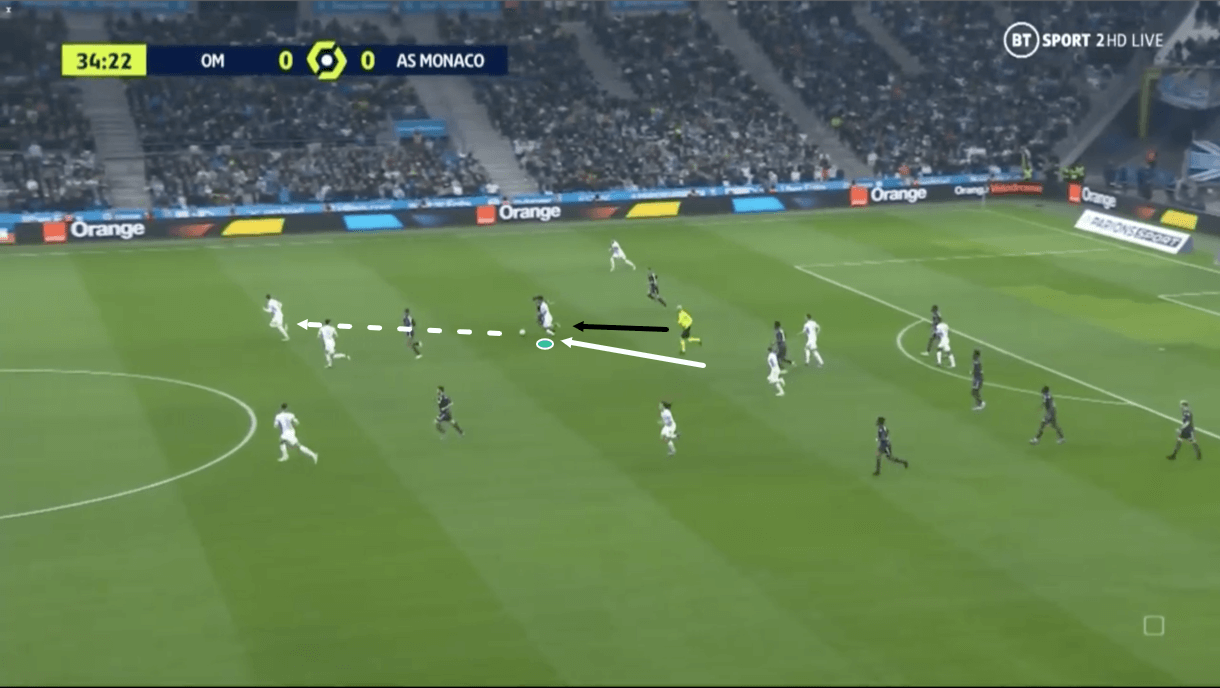
As play then progresses into figure 15, we see that the ball-carrier opted to try and continue bringing the ball forward himself rather than pass to a teammate immediately, while Kamara used his pace and intelligent positioning to shepherd the ball-carrier away from more dangerous zones out towards the wide-area while continuing to make passes into more threatening central positions unattractive through his body positioning. As play moves on from here, we see Kamara make a tackle that forces a turnover, with the ball flying back into the path of Marseille’s left centre-back.
This passage of play is a typical example of Kamara’s role in transition to defence and how his qualities of spatial awareness, decisiveness, quickness and comfortability with defending aggressively can all combine to help him effectively perform his central role in stalling the opposition in transition and ending their counter-attack. The effective way in which he performs this role also helps Marseille to regain possession quickly and in a dangerous position, allowing them to keep pressure sustained on the opposition’s defence while also potentially creating an opportunity to hit them hard while disorganised in transition back to defence themselves.
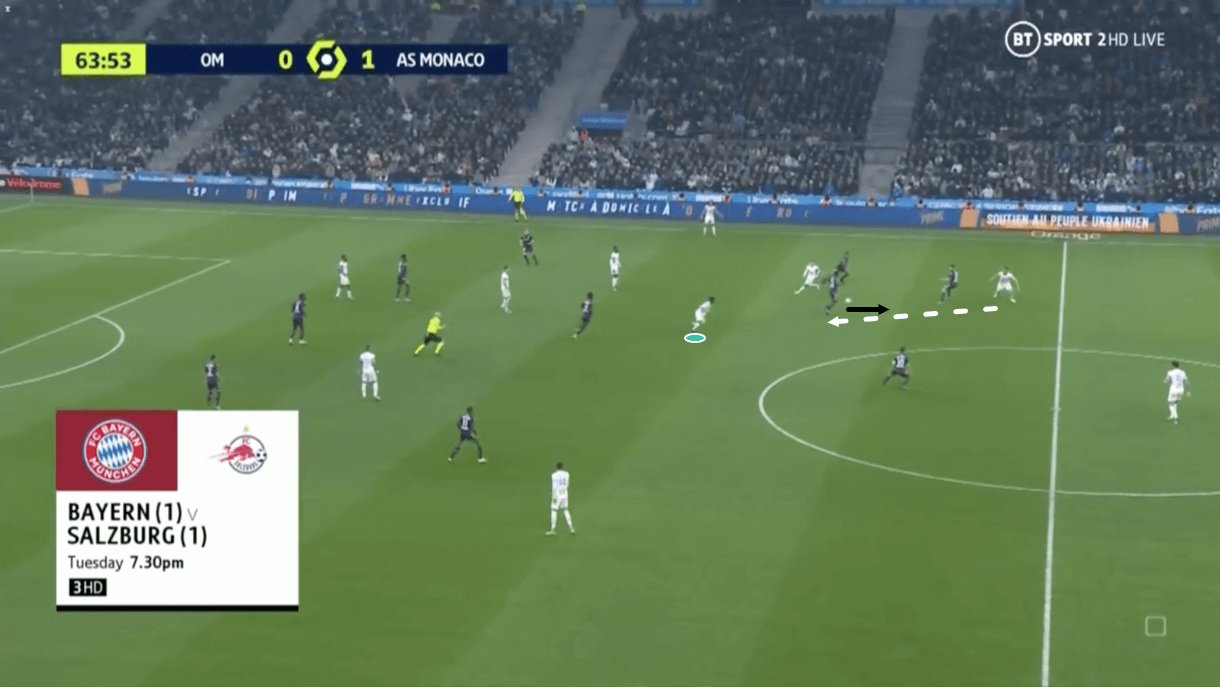
Kamara’s defensive qualities are also important in transition to defence in deeper areas, with figures 16-17 showing an example of one such situation. Firstly, in figure 16, we see Marseille in their offensive shape during the progression phase. At this moment, Kamara is positioned just behind the opposition’s first line of pressure and the right centre-back had just attempted to hastily send the ball into midfield. This pass was easily intercepted by an opposition player, creating an opportunity for a very dangerous transition attacking Marseille’s weakened backline.
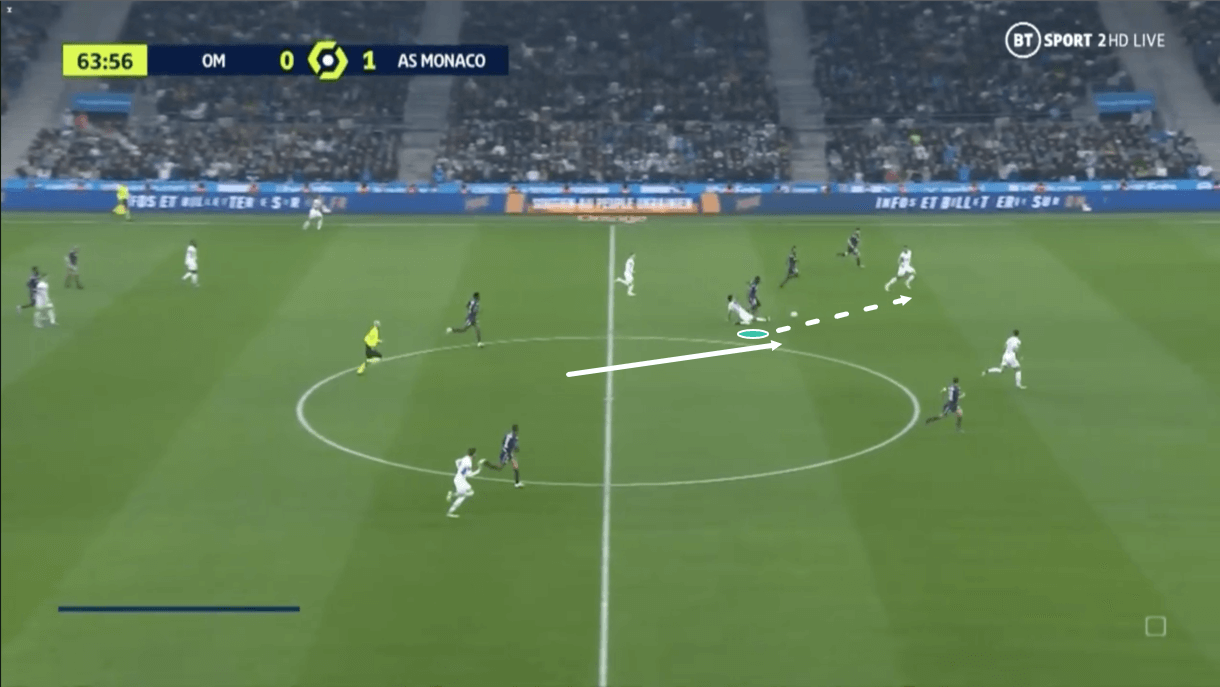
Thanks to his awareness, alertness and speed, Kamara was able to help fix this very big problem for his team, as he quickly darted back, caught up with the opposition ball-carrier as Monaco were overloading Marseille’s backline, and pulled off a fantastic slide tackle that knocks the ball back into his team’s grasp, depicted in figure 17. This was an incredible bit of defending from the holding midfielder as he managed to win possession cleanly but I imagine Kamara quickly made the decision here that he’d be going to ground early regardless of whether this resulted in a clean tackle or not. Again, this highlights his aggressiveness and decisiveness in defensive situations, as well as a tactical intelligence, as he’s willing to give away the foul early, in a less threatening position, to prevent the opposition from progressing into a more valuable position from where they could either create a goal or get fouled with a greater chance of converting the resulting free-kick — another important trait to have in transition to defence with a ball-dominant team.
Conclusion
To conclude this tactical analysis and scout report, I hope it’s clearer why I believe Kamara should be one of the most sought-after names on the market this summer, should he become a free agent as it looks likely at present in a few months. I’d recommend Kamara as an option to any elite clubs in need of a holding midfielder, certainly those who tend to dominate the ball more.
I also hope this tactical analysis and scout report has highlighted the important role this midfielder has played for his team to help them to remain on the tail of league leaders PSG, while getting to this point of the campaign as the team most likely to achieve UEFA Champions League qualification after PSG, beating the likes of Rennes, Nice, Strasbourg and Lille to second-place with nine games remaining. This wouldn’t have been possible without a lot of things but for sure, I’d say Marseille wouldn’t have done this in the way they have if not for Kamara performing his central role in this team to such a high standard.

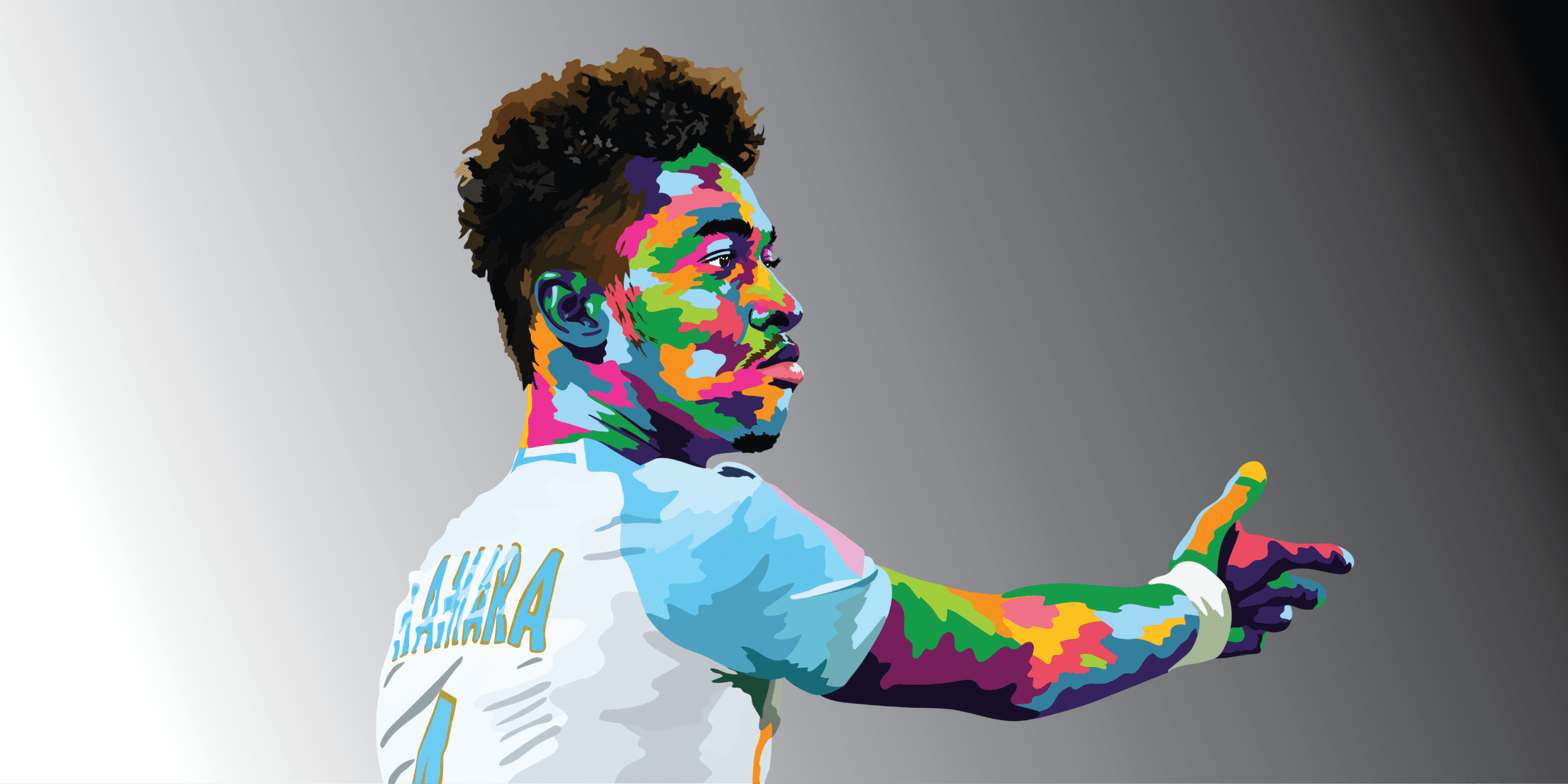


Comments